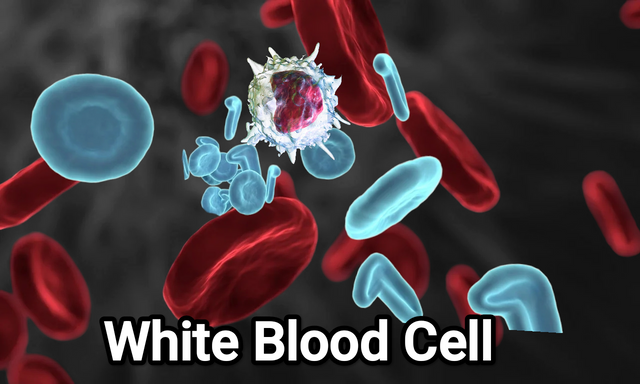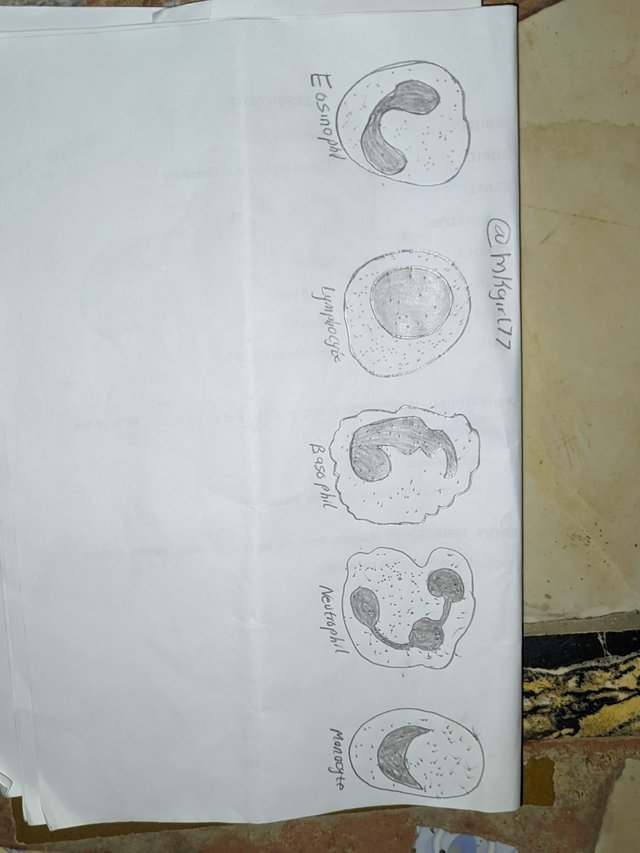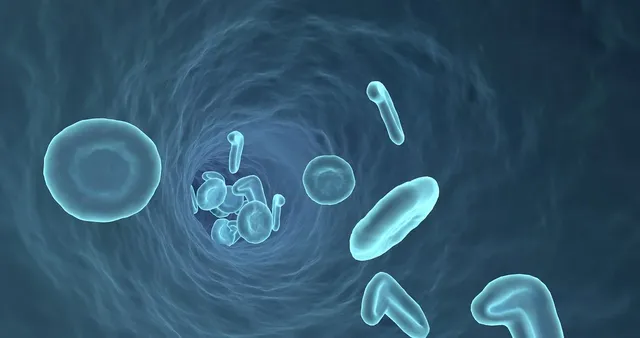
Canva transformation
Today we are going to talk about white blood cells after taking time to go through this interesting class. Let's dive in, shall we?
Define White Blood Cells
White blood cells (WBC's) are also called leukocytes meaning leuko--white and cyte--cell. These cells serve as the body's own soldiers, constantly monitoring your bloodstream to protect it from external threats such as bacteria, viruses, and infections. White blood cells are found in the lymphatic system and blood and, in contrast to red blood cells, which are specialized in the movement of oxygen, are in charge of identifying threats to your body and launching an attack when needed to neutralize dangerous pathogens before they cause significant damage.
White blood cells, which make up 1% of your blood, are larger and less frequent than red blood cells. They also have a unique nucleus and an uneven, transparent shape. They are produced in the bone marrow and kept in the lymph and blood tissues.
White blood cells are made of different types, each of them with its own specific function.
Whether it is healing wounds, fighting infections or creating antibiotics, without them our bodies would be vulnerable to infections and disease. A healthy adult's white blood cell count ranges from 4000 to 11,000 per microliter of blood.
The Modern Biology Textbook, written by Sarojini T. Ramalingam, makes reference to this comprehensive definition.
Make a diagram of the white series
Above is a diagram of the white series showing the parent cell (hematopoietic stem cell) and it's types. The different types of White blood cells include;
- Granulocytes: These are White blood cells that contain granules with protein. They are the first responders in our immune system and is made up of 3 types of granulocyte cells;
Basophils: They are rare and act like the body's response system during allergic reactions. They also release chemicals to help control inflammation.
Eosinophils: They are responsible for response to infection from parasites like worms and play a major role in defending the immune system against invaders.
Neutrophils: They are the most common WBC's. They act as scavengers and specialise in destroying bacteria and fungi that may be present in the body.
- Monocytes: They make up 2-8% of white blood cells in our body. They act as macrophages, cleaning up dead cells and destroying any foreign substances that cause infections. They also make sure the body heals after injuries.
- Lymphocytes: These are specialised white blood cells that include;
T Cells: Also called T-lymphocytes. They directly attract and remove infected and cancer cells.
B Cells : Also called B-lymphocytes. They produce antibodies that help the immune system fight invaders like bacteria and viruses.
Natural Killer Cells: Also called NK Cells. They are responsible for attacking and destroying viral or abnormal cells quickly.

Neutrophilia vs Neutropenia
| Description | Differences |
|---|---|
| Neutrophilia | This is when there is an abnormally high number of neutrophil in the blood. |
| Neutropenia | This is when there is an abnormally low number of neutrophil in the blood. |
Neutrophil Count
| Neutrophilia | Has a neutrophil count of over 7,000 per microliter of blood. |
|---|---|
| Neutropenia | contains smaller than 1,500 neutrophils per microliter of blood. |
Causes
| Neutrophilia | Caused by Bacterial infections, inflammation, physical stress or smoking. |
|---|---|
| Neutropenia | Occurs due to Viral infections, chemotherapy, and bone disease. |
Symptoms
| Neutrophilia | frequently without symptoms but may show signs of fever or swelling due to inflammation. |
|---|---|
| Neutropenia | Due to a weakened vulnerable system, symptoms could include fatigue, fever, or intermittent infections. |
Factors associated with risk
| Neutrophilia | Can increase the threat of severe inflammation. |
|---|---|
| Neutropenia | Increases the threat of severe infections, including respiratory and skin infections. |
Duration
| Neutrophilia | When the infection or its cause is treated, it generally goes down temporarily. |
|---|---|
| Neutropenia | It may be more severe or connected to a very serious bone marrow problem. |
Treatment
| Neutrophilia | can be managed by treating the root cause, which is similar to using antibiotics for treating an infection. |
|---|---|
| Neutropenia | may include taking medicines, or indeed quitting dangerous substances like alcohol. |
Explain a case related to the white series
| Case study | Chemotherapy induced Neutropenia |
|---|---|
| Patient name: | Peter |
| Age: | 40 |
| Gender | Male |
Clinical History:
The patient was presented with fatigue, frequent fever, chills and recurrent infections from wound and inflammation that has refused to heal.
Lab Examination:
The patient was asked to carry out series if blood tests including a full blood count. When the results were out, it was revealed that Peter had very low neutrophil cell count.
Lab Results:*
| White blood cell count | 2,600uL (which is low) compared to the normal that is 4000-11,000uL |
|---|---|
| Neutrophil count | 800uL (very very low) compared to the normal which is 1500-7000. |
| Hemoglobin count | 16.0g/dL which was normal |
| Platelets count | 200,000 which was also normal |
Medical Diagnosis:*
The doctor concluded that Peter had neutropenia probably induced by chemotherapy since he was recently receiving treatment for cancer. These Neutrophils count has been significantly reduced because of the radiation exposure from chemo. Even though chemo's job is to reduce cancer cells, it can also affect the bone marrow that produces these Neutrophils.
Because of the low neutrophil count, Peter's body became vulnerable to infections. And because his body kept fighting the infections, it lead to his constant fevers and tiredness. Apparently, his immune system became weak.
Treatment:*
Peter's doctor prescribed medications like granulocyte colony stimulating factor (G-CSF) to help his bone marrow produce more neutrophils and reduce the risk of infections during chemotherapy. He was also encouraged to maintain a good hygiene and avoid crowds to prevent him from getting more infections.
By sticking to all these guidelines, the patient will be able to recover and his Neutrophils count will be back to normal.

Gracias por comprender la clase y entregarnos una asignación, espero ser lo más clara contigo con respecto a mis notas, por favor disfrute del proceso junto a nosotras♥
Explicaste muy bien el concepto de Glóbulos blancos y sus características generales, sin embargo falto mencionar a las células que están involucradas en este proceso de inmunidad, aun asi valoramos su esfuerzo.
Hiciste un magnífico trabajo definiendo las funciones de las células blancas en este punto, pero al diagrama le falto algo de creatividad o colores. Pero esperamos que te hayas divertido en el proceso!
Explicaste las diferencias de forma correcta, hiciste varios cuadros, pero hubiera sido estupendo realizar solo un cuadro con las características fundamentales, aun así valoramos su esfuerzo!
¡Excelente, explicaste muy bien el caso clínico! Destacaste los puntos importantes para el diagnóstico y también te aseguraste de no dejar por fuera los valores de laboratorio, normalmente debido a esos tratamientos los leucocitos suelen bajar de valores drásticamente. Esperamos que te haya gustado mucho participar en este modulo y nos vemos en la próxima temporada.
Downvoting a post can decrease pending rewards and make it less visible. Common reasons:
Submit
Thank you for publishing an article in the Steem Kids & Parent community today. We have assessed your entry and we present the result of our assessment below.
MODs Comment/Recommendation:
It is fascinating to learn how these cells act as the body's guards, constantly monitoring for threats such as bacteria and viruses.
Remember to always share your post on Twitter. This POST LINK is a guide to that effect.
Please join our curation trail by following the guidelines in the post link below
https://steemit.com/hive-139765/@steemkidss/join-steem-kids-and-parents-community-s-official-curation-trail-steemkidss
Downvoting a post can decrease pending rewards and make it less visible. Common reasons:
Submit